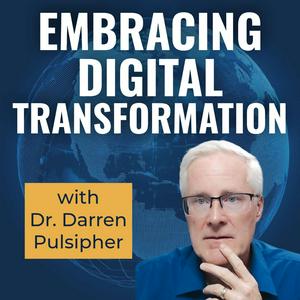Embracing Digital Transformation

310 afleveringen

#313 Navigating the Intersection of AI and Cybersecurity
16-12-2025 | 34 Min.
Welcome to a fascinating conversation that dives deep into the complex relationship between AI and cybersecurity. In this episode, host Dr. Darren speaks with Walter Haydon, an AI cybersecurity expert who sheds light on how modern threats evolve and the unique challenges organizations face in securing their AI systems. ## Key Takeaways: - Cyber threats are evolving rapidly, with AI being leveraged by both malicious actors and cybersecurity professionals. - Espionage and data theft remain pressing issues, particularly from state actors like the Chinese government, who exploit advanced technologies for intelligence gathering. - Organizations need to adopt a more probabilistic approach to risk management in the face of non-deterministic AI behavior. - Implementing clear policies, conducting asset inventories, and performing comprehensive risk assessments are essential steps for organizations deploying AI. - Understanding the provenance of AI models and verifying their security is critical to mitigate risks when using either public or private AI solutions. - Regular integrity checks on AI outputs can help maintain the reliability and security of AI systems. ## Chapters: - 00:00 - Introduction - 01:30 - Walter Haydon's Haydon'snd - 05:00 - Evolution of Cybersecurity Threats - 10:15 - AI's Cybersecurity - 15:50 - Espionage vs Cyber Attacks - 20:00 - Approaching AI Implementation Securely - 25:30 - Risk Management Strategies - 30:00 - Tools for Securing AI Systems - 35:00 - The Future of AI and Cybersecurity - 40:00 - Closing Thoughts and Resources Engage with us to learn how these insights can apply to your own practices! Don’t forget to check out the episode on your favorite podcast platform and connect with us through social media! The Vital Intersection of AI and CybersecurityIn today's landscape, the conversation around artificial intelligence (AI) isn't just a trending topic for tech enthusiasts; it's a pivotal concern for business leaders everywhere. Understanding how AI intertwines with cybersecurity can spell the difference between risk and resilience for organizations of all sizes. In a recent discussion with AI and cybersecurity expert Walter Haydon, we unpacked the nuanced relationship between these two critical domains. With escalating threats from cyber adversaries, particularly state-sponsored entities, organizations must cultivate an awareness that enables them to proactively defend not just their legacy systems, but also their burgeoning AI technologies. The Evolving Threat Landscape Cyber Espionage vs. Cyber AttacksCybersecurity isn't merely about defending against breaches; it encompasses a spectrum of challenges, including espionage and data theft. Haydon points to the Chinese government's long-term strategy to gather information on U.S. citizens as a prime example, highlighting incidents like the Office of Personnel Management hack that compromised sensitive data, including biometrics.Understanding the difference between cyber espionage — a method aimed primarily at intelligence gathering — and crippling cyberattacks against infrastructure is crucial. Not all threats manifest in immediate danger; many form part of a larger strategy that targets information for future use. # Key Takeaways:- Cyber espionage involves gathering sensitive data for strategic advantages.- Cyber attacks are immediate and often disruptive.- Both require tailored strategies for effective defense. The Acceleration of AI-Powered ThreatsAs AI technologies continue to advance, cyber adversaries are quick to exploit them, enhancing the scale and sophistication of their attacks. Haydon underscores that AI not only assists cybersecurity professionals but also provides new tools for cybercriminals. This dual-edged scenario necessitates a proactive stance in cybersecurity measures. Popular Attack Vectors- Phishing remains the leading entry point for cybercriminals, underscoring the need for employee training.- Ransomware attacks jeopardize operational continuity by denying access to key systems.- AI models can be weaponized through prompt injection, introducing new vulnerabilities without traditional defensive measures. Proactive Measures for Secure AI Deployment Preparing for the Uncertainty of AIOrganizations adopting AI must navigate its inherent unpredictability, which complicates their security posture. Establishing clear policies about acceptable AI usage lays the foundation for responsible adoption. Haydon recommends conducting comprehensive risk assessments that map out the permissible use of AI applications.Organizations should not only invest in training their staff but also in maintaining an inventory of AI assets and their vulnerabilities. # Best Practices to Implement:- Develop clear policies regarding AI usage and data handling.- Conduct regular risk assessments focusing on AI tools and their intended use.- Monitor and audit AI systems to catch anomalies and correct course when necessary. Tools for Effective ManagementAs organizations grapple with safeguarding their assets, tools that monitor and govern AI applications are essential. Haydon emphasizes the importance of employing asset management systems that not only assess current applications but also analyze the data used to train AI models. Organizations can apply cybersecurity measures, such as rate limiting and integrity checks, to AI outputs to mitigate risks and protect sensitive information. Closing ThoughtsThe conversation about AI and cybersecurity may be daunting, but it has also fostered an environment where awareness and readiness can lead to significant enhancements in organizational strength. To truly thrive in a technology-driven landscape, leaders must embrace the proactive management of cybersecurity and AI, ensuring that they mitigate risks while harnessing the transformative capabilities of these technologies.For further insights on managing cybersecurity in an AI-enabled world, reach out to experts like Walter Haydon at Stack Aware, and share this article with your peers to foster broader discussions on these vital topics. If you found this information valuable, don't forget to check out our whole discussion and explore more resources at Embracing Digital Transformation.

Navigating the Intersection of AI and Cybersecurity
16-12-2025 | 0 Min.
Welcome to a fascinating conversation that dives deep into the complex relationship between AI and cybersecurity. In this episode, host Dr. Darren speaks with Walter Haydon, an AI cybersecurity expert who sheds light on how modern threats evolve and the unique challenges organizations face in securing their AI systems. ## Key Takeaways: - Cyber threats are evolving rapidly, with AI being leveraged by both malicious actors and cybersecurity professionals. - Espionage and data theft remain pressing issues, particularly from state actors like the Chinese government, who exploit advanced technologies for intelligence gathering. - Organizations need to adopt a more probabilistic approach to risk management in the face of non-deterministic AI behavior. - Implementing clear policies, conducting asset inventories, and performing comprehensive risk assessments are essential steps for organizations deploying AI. - Understanding the provenance of AI models and verifying their security is critical to mitigate risks when using either public or private AI solutions. - Regular integrity checks on AI outputs can help maintain the reliability and security of AI systems. ## Chapters: - 00:00 - Introduction - 01:30 - Walter Haydon's Haydon'snd - 05:00 - Evolution of Cybersecurity Threats - 10:15 - AI's Cybersecurity - 15:50 - Espionage vs Cyber Attacks - 20:00 - Approaching AI Implementation Securely - 25:30 - Risk Management Strategies - 30:00 - Tools for Securing AI Systems - 35:00 - The Future of AI and Cybersecurity - 40:00 - Closing Thoughts and Resources Engage with us to learn how these insights can apply to your own practices! Don’t forget to check out the episode on your favorite podcast platform and connect with us through social media! The Vital Intersection of AI and CybersecurityIn today's landscape, the conversation around artificial intelligence (AI) isn't just a trending topic for tech enthusiasts; it's a pivotal concern for business leaders everywhere. Understanding how AI intertwines with cybersecurity can spell the difference between risk and resilience for organizations of all sizes. In a recent discussion with AI and cybersecurity expert Walter Haydon, we unpacked the nuanced relationship between these two critical domains. With escalating threats from cyber adversaries, particularly state-sponsored entities, organizations must cultivate an awareness that enables them to proactively defend not just their legacy systems, but also their burgeoning AI technologies. The Evolving Threat Landscape Cyber Espionage vs. Cyber AttacksCybersecurity isn't merely about defending against breaches; it encompasses a spectrum of challenges, including espionage and data theft. Haydon points to the Chinese government's long-term strategy to gather information on U.S. citizens as a prime example, highlighting incidents like the Office of Personnel Management hack that compromised sensitive data, including biometrics.Understanding the difference between cyber espionage — a method aimed primarily at intelligence gathering — and crippling cyberattacks against infrastructure is crucial. Not all threats manifest in immediate danger; many form part of a larger strategy that targets information for future use. # Key Takeaways:- Cyber espionage involves gathering sensitive data for strategic advantages.- Cyber attacks are immediate and often disruptive.- Both require tailored strategies for effective defense. The Acceleration of AI-Powered ThreatsAs AI technologies continue to advance, cyber adversaries are quick to exploit them, enhancing the scale and sophistication of their attacks. Haydon underscores that AI not only assists cybersecurity professionals but also provides new tools for cybercriminals. This dual-edged scenario necessitates a proactive stance in cybersecurity measures. Popular Attack Vectors- Phishing remains the leading entry point for cybercriminals, underscoring the need for employee training.- Ransomware attacks jeopardize operational continuity by denying access to key systems.- AI models can be weaponized through prompt injection, introducing new vulnerabilities without traditional defensive measures. Proactive Measures for Secure AI Deployment Preparing for the Uncertainty of AIOrganizations adopting AI must navigate its inherent unpredictability, which complicates their security posture. Establishing clear policies about acceptable AI usage lays the foundation for responsible adoption. Haydon recommends conducting comprehensive risk assessments that map out the permissible use of AI applications.Organizations should not only invest in training their staff but also in maintaining an inventory of AI assets and their vulnerabilities. # Best Practices to Implement:- Develop clear policies regarding AI usage and data handling.- Conduct regular risk assessments focusing on AI tools and their intended use.- Monitor and audit AI systems to catch anomalies and correct course when necessary. Tools for Effective ManagementAs organizations grapple with safeguarding their assets, tools that monitor and govern AI applications are essential. Haydon emphasizes the importance of employing asset management systems that not only assess current applications but also analyze the data used to train AI models. Organizations can apply cybersecurity measures, such as rate limiting and integrity checks, to AI outputs to mitigate risks and protect sensitive information. Closing ThoughtsThe conversation about AI and cybersecurity may be daunting, but it has also fostered an environment where awareness and readiness can lead to significant enhancements in organizational strength. To truly thrive in a technology-driven landscape, leaders must embrace the proactive management of cybersecurity and AI, ensuring that they mitigate risks while harnessing the transformative capabilities of these technologies.For further insights on managing cybersecurity in an AI-enabled world, reach out to experts like Walter Haydon at Stack Aware, and share this article with your peers to foster broader discussions on these vital topics. If you found this information valuable, don't forget to check out our whole discussion and explore more resources at Embracing Digital Transformation.

#312 Leading Through Uncertainty: How Digital Transformation, AI, and Fit Organizations Drive Innovation
11-12-2025 | 33 Min.
Are you comfortable with uncertainty? Join Dr. Darren as he talks with entrepreneur Jeff about the realities of embracing digital transformation in uncertain times. They explore how a mindset shift can empower teams and companies to adapt and thrive amidst challenges, all while navigating the landscape of technology and change. ## Key Takeaways: - **Embrace Uncertainty**: Entrepreneurs are not necessarily risk-takers; they are individuals who are comfortable with uncertainty and leverage it as an asset. - **Team Performance Matters**: In a reshaping corporate landscape, identifying your team's strengths and weaknesses is crucial for effective performance management. - **Cultural Evolution**: Fostering a culture of internal disruption can lead to innovation, rather than fearing change. - **Lean and Agile**: The economy of scale has shifted; businesses can achieve more with fewer resources when they adapt their structures and mindset. - **Continuous Improvement**: Companies must commit to ongoing development, not just in terms of resources but also in their operational fitness. - **Customer-Centric Focus**: Understand what your customer truly values and provide it consistently to remain relevant in a changing market. ## Chapters: - 00:00 How Entrepreneurs Navigate Uncertainty - 05:45 The Role of Team Performance - 11:30 Empowering Internal Disruption - 17:00 The Shift in Organizational Structures - 22:15 Continuous Improvement in Business - 27:00 Understanding Customer Needs - 32:45 Closing Thoughts and Resources --- Listen to the full conversation to unlock more insights on digital transformation and embrace the uncertainty that comes with it. Don’t forget to share this episode with your network to spread knowledge about navigating the evolving business landscape! Navigating the Entrepreneurial LandscapeIn a world where uncertainty reigns, entrepreneurs thrive by embracing the unpredictable. Today, we dive into insights from **Doctor Darren**, a chief enterprise architect and educator, alongside seasoned entrepreneur **Jeff**, who sheds light on how to navigate uncertainty in business, and the importance of adapting to ever-changing landscapes. Understanding this topic is crucial for both technologists and business leaders. It highlights how embracing uncertainty can fuel innovation and success, ultimately leading to transformational change within their organizations. Shifting Perspectives on Risk The True Nature of EntrepreneurshipEntrepreneurship is often romanticized as an adventure filled with risk-taking or daring ventures, like jumping off a cliff and building an airplane on the way down. However, the essence of an entrepreneur is being comfortable with uncertainty. Entrepreneurs embrace unpredictability and leverage their skills, experience, and adaptability to navigate turbulent waters.This shift from viewing risk as merely dangerous to understanding it as an opportunity opens up a world of possibilities. By rethinking their approach, entrepreneurs can harness their strengths and create innovative solutions for uncharted challenges.**Key Takeaways:**- Embrace risk by reframing it as uncertainty.- Leverage your skills and experience to navigate challenges.- Foster adaptability to embrace change. Building Resilience in Teams Harnessing the Power of CollaborationIn today's business environment, the most successful organizations foster strong, resilient teams. Jeff emphasizes that effective teams do not solely follow a hierarchy. Instead, they thrive on collaboration, allowing members to share ideas and take ownership of their contributions.Encouraging open communication creates a culture of innovation, where team members feel empowered to suggest bold ideas and experiment with new approaches. This is especially vital during periods of uncertainty, where organizations must pivot quickly to remain competitive.**Key Takeaways:**- Promote teamwork and collaboration to foster innovation.- Encourage open communication for a culture of transparency.- Empower team members to take ownership of their contributions. The Path Forward: Adaptation and Growth Developing Organizational AgilityTo thrive in today's fast-paced landscape, organizations need to develop their agility. This involves continuous evaluation of both their internal processes and external opportunities. By focusing on performance metrics, leaders can enhance team productivity, enabling them to adapt to industry trends swiftly.Incorporating technology plays a vital role in this transformation. By implementing agile processes and restructuring teams, organizations can efficiently respond to market demands and customer needs.**Key Takeaways:**- Continuously evaluate internal processes and external opportunities.- Focus on performance metrics to optimize team productivity.- Leverage technology to support organizational agility.Now that you've explored the key elements for thriving amid uncertainty, consider how you can apply these insights within your own organization. Embrace the inherent unpredictability of the business landscape, spark collaboration among your team, and cultivate an agile mindset to foster long-term growth.If you're eager to learn more and explore further insights, consider listening to the full discussion with Jeff and Doctor Darren. There's plenty of valuable knowledge to deepen your understanding of these themes and enrich your leadership journey.

#311 The Future of AI Education: Transforming Lives and Careers
09-12-2025 | 34 Min.
In our rapidly evolving world, the urgency to integrate AI into education has never been clearer. Join Doctor Darren as he chats with industry veterans Pedro Santos and Antonio Delgado from Miami-Dade Community College, who are on a mission to revolutionize AI education. They share their insights on how education must adapt to the changing landscape, empowering individuals from diverse backgrounds to thrive in an AI-driven future. ## Key Takeaways: - **AI integration in education:** It is essential for staying relevant in today's job market. Upskilling in AI can secure employment opportunities and enhance career growth. - **Diverse audience:** The average student in the AI program is 38 years old, showcasing that AI education appeals to working professionals across various industries. - **Community impact:** Miami-Dade College's AI initiatives emphasize creating pathways for prosperity, especially for those from underserved communities. - **Hands-on learning:** The stackable credential approach allows students to gain relevant skills quickly, fostering real-world applications and entrepreneurial ventures. - **Collaborative partnerships:** The success stories of AI education are boosted by strategic alliances with industry leaders like Intel, which provide essential resources and curriculum support. - **Accessible resources:** AI education does not require expensive infrastructure; cloud-based tools and community support can bridge the gap for aspiring learners. ## Chapters: - [00:00] Introduction to AI education - [05:11] Background stories of Pedro and Antonio - [10:20] The impact of generative AI on education - [15:40] Student demographics and program success - [21:00] Future vision for AI education at Miami-Dade College - [30:15] Community resources and outreach efforts - [35:40] Conclusion and ways to get involved If you're interested in reshaping your understanding of AI and its role in education, listen to the full episode for deeper insights and actionable strategies! Shaping Today’s Learning LandscapeIn a world increasingly driven by technology, the demand for AI education has reached a pivotal point. Doctor Darren, a thought leader in digital transformation, brings voices from the frontlines of this revolution in education. Joined by experts Antonio Delgado and Pedro Santos from Miami-Dade Community College, this discussion explores how AI is not just a tool but a transformative force in education, enhancing skills relevant to today's jobs.Understanding the intersection of technology and education is essential for business leaders and technologists alike. This blog explores how institutions are adapting to meet diverse learning needs while promoting career growth across industries. The Impact of AI on Education Bridging Skill Gaps and Fostering InnovationThe landscape of education is evolving rapidly, particularly with the advent of AI. Traditional methods are giving way to more dynamic and interactive approaches. Pedro Santos highlights a significant uptick in public interest in AI education. For instance, when Miami-Dade launched its Applied AI program, it anticipated 30 attendees but welcomed over 120—an indication of the hunger for knowledge in this area.AI is dramatically changing pedagogical frameworks. Programs now focus on practical applications rather than abstract theories, making technology more accessible. Through partnerships with industry leaders and educational institutions, Miami-Dade has become a hub for AI learning, opening pathways for over 700 individuals in its first year alone. This shift not only enhances individual skills but also directly supports workforce readiness and employment opportunities across industries. Addressing barriers such as cost, access, and digital literacy is essential to ensure these opportunities are truly inclusive and accessible to all learners. Key Takeaways:- Transitioning from theoretical to practical education enhances engagement.- AI is bridging skill gaps across various demographics.- Partnerships with industry leaders enhance learning quality and accessibility. Community-Centric Initiatives Addressing Local Needs through AI EducationOne of the most inspiring aspects of the AI education movement is its focus on community. Both Antonio and Pedro emphasize how their programs empower underserved groups, fostering hope and a belief in social mobility through education. The typical age of participants is notably higher than usual, at around 38, showing that working professionals are actively seeking to improve their skills and prospects.Miami-Dade's diverse program caters not just to tech-savvy individuals but to a spectrum of learners. This multifaceted approach fosters community engagement, resilience, and entrepreneurship, particularly among those who may not have the resources to pursue traditional four-year degrees. Key Takeaways:- Programs foster entrepreneurship and community growth.- Diverse age demographics represent a shift in educational participation.- Community engagement leads to a more resilient workforce. A Call for Collaboration Joining the MovementThe future of education depends on how institutions like Miami-Dade adapt to challenges posed by AI. By developing programs that prioritize skill acquisition over traditional degrees, Miami-Dade demonstrates leadership and inspires confidence in innovative, inclusive education models.This message encourages technologists and business leaders to see collaboration as essential for success. By working together, institutions can ensure equitable access to cutting-edge education, fostering a collective sense of purpose and shared progress. Key Takeaways:- Collaboration among educational institutions is crucial for success against AI's rapid advancements.- Skills-based education reshapes pathways for many learners.- Institutional partnerships can amplify educational impact.To stay informed about these transformative educational initiatives and to witness the ongoing evolution of AI education, consider exploring the resources available from Miami-Dade Community College and joining the movement towards accessible education for all.Make sure to stay engaged by following developments, and consider how AI skills can impact your career or organization in today's rapidly changing workforce. The future is here, and embracing AI within education is an imperative step towards a more prosperous and equitable tomorrow.

#310 Why IT–OT Convergence Is the Future of Cybersecurity in Critical Infrastructure
04-12-2025 | 33 Min.
Are you curious about how the convergence of Information Technology (IT) and Operational Technology (OT) can revolutionize cybersecurity in critical infrastructure? Join Dr. Darren, your engaging host, and Santosh Kabaddi, CEO of Pro Arch, as they delve into the complexities of converged Over-The-Top (OTT) technology and its crucial role in safeguarding our digital world. ## Key Takeaways: - **Embrace Convergence**: Successfully merge IT and OT to create a robust, cyber-resilient infrastructure. - **Data Governance**: Establish federated domain-centric governance for better data visibility and quality. - **Security First**: Embed cybersecurity measures from the start; it's not just an afterthought. - **Real-time Monitoring**: Utilize digital twins to enhance predictive maintenance and visibility into systems. - **Cultural Shift**: Foster a culture of collaboration and transparency between IT and OT departments to reduce risks. - **Edge Computing**: Leverage the power of edge devices and AI solutions for smarter operational efficiencies. ## Chapters: - 00:00 - Opening Thoughts on Cybersecurity Risks in OT - 05:03 - Guest Introduction: Santosh Kabaddi - 10:15 - The Importance of Data Visibility - 17:40 - Understanding the Convergence of IT and OT - 24:05 - Creating Real-time Digital Twins for Better Decision Making - 30:50 - Defining the Future of Robotics in OT - 35:00 - Security Measures for Emerging Technologies - 40:20 - Closing Remarks and Takeaways Dive into this insightful episode and discover how converged OTT can be a game changer for your organization, ensuring cybersecurity isn't just a checklist item but a core aspect of your operational strategy. Don't miss out – listen today! Navigating the Complexities of CybersecurityIn today’s fast-evolving technological landscape, the convergence of operational technology (OT) and information technology (IT) is a hot topic, rife with both opportunity and risk. The insights from Doctor Darren and Santosh Kabaddi, CEO of Pro Arch, shed light on this critical intersection, exploring how organizations can effectively embrace digital transformation while managing cybersecurity threats. This conversation is invaluable for technologists and business leaders eager to understand the ramifications of operational risks in their strategy.Understanding converged OTT and its cybersecurity implications is essential for businesses striving to remain competitive. To effectively manage risks, organizations should adopt specific cybersecurity strategies such as network segmentation, continuous monitoring, and incident response plans. To overcome silos, organizations should establish cross-functional teams, hold joint training sessions, and share KPIs. Listening to industry experts unravel the complexities of this topic not only enhances comprehension but also provides actionable insights for enhancing digital resilience. The Necessity of Cybersecurity in Converged OTT The Risks of Air-Gapped SystemsFor many organizations traditionally reliant on air-gapped systems, cybersecurity often remains an afterthought. Experts agree that merely isolating systems offers a false sense of security. As Darren points out, vulnerabilities persist even in environments considered secure. The infamous Stuxnet attack demonstrates how air-gapped systems can be exploited, proving that cyber threats are an ongoing challenge across all sectors, especially in critical infrastructures such as energy and manufacturing.The recent conversation underscores the common misconception that if systems aren’t connected to the internet, they are inherently safe. Santosh emphasizes that being “data rich but information poor” leaves organizations exposed to unforeseen risks. The integration of advanced cybersecurity protocols becomes crucial in addressing these vulnerabilities and ensuring comprehensive protection. Bridging the Divide Between IT and OTEffective communication and collaboration between IT and OT departments are essential in converged environments. Santosh highlights that many organizations often find their OT and IT teams working in silos, speaking different languages and lacking a cohesive strategy. Creating a culture of collaboration can significantly enhance overall security posture. Implementing a "one lake" data management strategy that prioritizes data visibility and intelligent alignment between IT and OT fosters a strong foundation for integrated operations. It enables organizations to streamline processes, improve decision-making, and use data more efficiently.# Key Takeaways:- **Invest in Cybersecurity**: Treat security as a foundational component from the ground up.- **Foster Communication**: Build bridges between IT and OT through regular collaboration and shared goals.- **Emphasize Data Visibility**: Ensure access to real-time data insights across departments to improve risk management. Strategies for Effective Data Governance and Risk Management From Theory to PracticeSantosh advocates for a proactive approach to data governance that includes clear accountability through federated domain-centric governance frameworks. This approach places data management in the hands of those closest to it, helping your audience feel more in control and empowered to make informed decisions. This can foster a sense of shared responsibility and motivation to uphold security standards.Data governance, combined with a focus on security, helps organizations identify potential risks and equips them to act swiftly to mitigate threats. As organizations transition toward greater automation and artificial intelligence (AI), Santosh emphasizes that investment in data quality is non-negotiable. A Call for Cultural ChangeChanging the mindset across an organization is one of the most effective strategies for achieving successful digital transformation. Stakeholders must prioritize security and data management on their agendas while ensuring everyone understands their role in safeguarding sensitive information.Innovative technologies combined with a robust governance foundation create a competitive edge in the marketplace. As new technologies such as AI and machine learning continue to evolve, businesses can leverage them effectively to enhance data visibility and responsiveness, enabling better decision-making.# Actionable Insights:- **Establish Federated Governance**: Create a governance structure that empowers teams to take ownership of data quality and security.- **Prioritize Cultural Change**: Instill a security-first mentality throughout the organization, promoting understanding of cybersecurity among all employees.- **Leverage Technology**: Utilize emerging tech such as AI to enhance data management and predictive analytics. Elevate Your Digital JourneyTo delve deeper into the nuances of converged OTT and cybersecurity, consider engaging with industry leaders like Darren and Santosh. Their expert insights can guide you toward making informed decisions regarding your organization’s digital transformation strategy.
Meer Zaken en persoonlijke financiën podcasts
Trending Zaken en persoonlijke financiën -podcasts
Over Embracing Digital Transformation
Luister naar Embracing Digital Transformation, Doorzetters | met Ruud Hendriks en Richard Bross en vele andere podcasts van over de hele wereld met de radio.net-app

Ontvang de gratis radio.net app
- Zenders en podcasts om te bookmarken
- Streamen via Wi-Fi of Bluetooth
- Ondersteunt Carplay & Android Auto
- Veel andere app-functies
Ontvang de gratis radio.net app
- Zenders en podcasts om te bookmarken
- Streamen via Wi-Fi of Bluetooth
- Ondersteunt Carplay & Android Auto
- Veel andere app-functies


Embracing Digital Transformation
download de app,
luisteren.



































